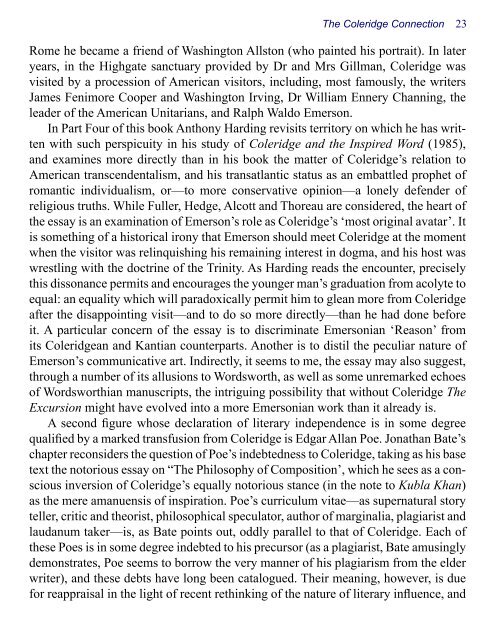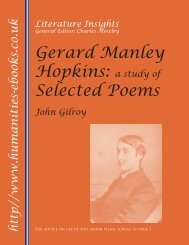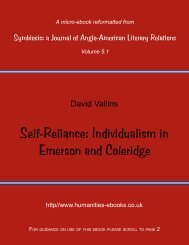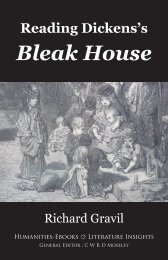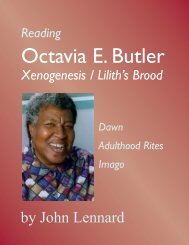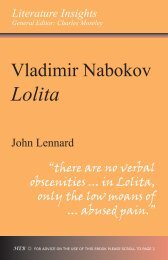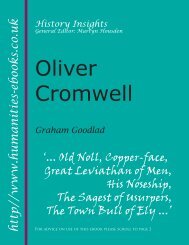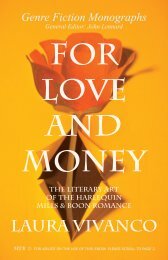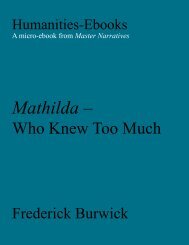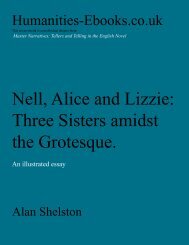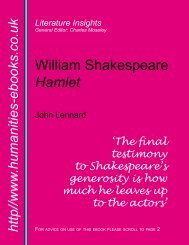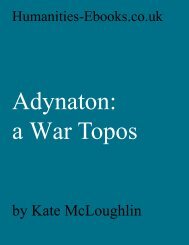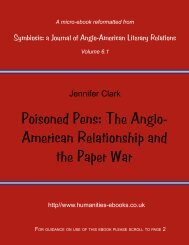The Coleridge Connection - Humanities-Ebooks
The Coleridge Connection - Humanities-Ebooks
The Coleridge Connection - Humanities-Ebooks
Create successful ePaper yourself
Turn your PDF publications into a flip-book with our unique Google optimized e-Paper software.
<strong>The</strong> <strong>Coleridge</strong> <strong>Connection</strong> 23<br />
Rome he became a friend of Washington Allston (who painted his portrait). In later<br />
years, in the Highgate sanctuary provided by Dr and Mrs Gillman, <strong>Coleridge</strong> was<br />
visited by a procession of American visitors, including, most famously, the writers<br />
James Fenimore Cooper and Washington Irving, Dr William Ennery Channing, the<br />
leader of the American Unitarians, and Ralph Waldo Emerson.<br />
In Part Four of this book Anthony Harding revisits territory on which he has written<br />
with such perspicuity in his study of <strong>Coleridge</strong> and the Inspired Word (1985),<br />
and examines more directly than in his book the matter of <strong>Coleridge</strong>’s relation to<br />
American transcendentalism, and his transatlantic status as an embattled prophet of<br />
romantic individualism, or—to more conservative opinion—a lonely defender of<br />
religious truths. While Fuller, Hedge, Alcott and Thoreau are considered, the heart of<br />
the essay is an examination of Emerson’s role as <strong>Coleridge</strong>’s ‘most original avatar’. It<br />
is something of a historical irony that Emerson should meet <strong>Coleridge</strong> at the moment<br />
when the visitor was relinquishing his remaining interest in dogma, and his host was<br />
wrestling with the doctrine of the Trinity. As Harding reads the encounter, precisely<br />
this dissonance permits and encourages the younger man’s graduation from acolyte to<br />
equal: an equality which will paradoxically permit him to glean more from <strong>Coleridge</strong><br />
after the disappointing visit—and to do so more directly—than he had done before<br />
it. A particular concern of the essay is to discriminate Emersonian ‘Reason’ from<br />
its <strong>Coleridge</strong>an and Kantian counterparts. Another is to distil the peculiar nature of<br />
Emerson’s communicative art. Indirectly, it seems to me, the essay may also suggest,<br />
through a number of its allusions to Wordsworth, as well as some unremarked echoes<br />
of Wordsworthian manuscripts, the intriguing possibility that without <strong>Coleridge</strong> <strong>The</strong><br />
Excursion might have evolved into a more Emersonian work than it already is.<br />
A second figure whose declaration of literary independence is in some degree<br />
qualified by a marked transfusion from <strong>Coleridge</strong> is Edgar Allan Poe. Jonathan Bate’s<br />
chapter reconsiders the question of Poe’s indebtedness to <strong>Coleridge</strong>, taking as his base<br />
text the notorious essay on “<strong>The</strong> Philosophy of Composition’, which he sees as a conscious<br />
inversion of <strong>Coleridge</strong>’s equally notorious stance (in the note to Kubla Khan)<br />
as the mere amanuensis of inspiration. Poe’s curriculum vitae—as supernatural story<br />
teller, critic and theorist, philosophical speculator, author of marginalia, plagiarist and<br />
laudanum taker—is, as Bate points out, oddly parallel to that of <strong>Coleridge</strong>. Each of<br />
these Poes is in some degree indebted to his precursor (as a plagiarist, Bate amusingly<br />
demonstrates, Poe seems to borrow the very manner of his plagiarism from the elder<br />
writer), and these debts have long been catalogued. <strong>The</strong>ir meaning, however, is due<br />
for reappraisal in the light of recent rethinking of the nature of literary influence, and


